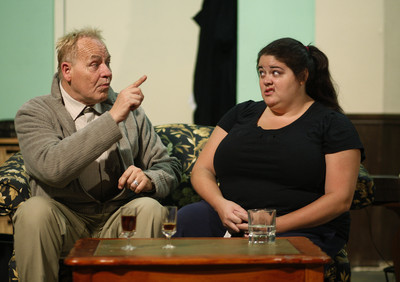‘How the Other Half Loves’ plays with time, space, social comedy
Linear logic and the laws of time and space? Narrative nuisances.
This setup disregards such dictates: Separate living rooms. Separate couples. Same guests arrive at both houses. For two separate dinner parties. On two separate nights.
All at once.
With a costume fitting and a dab of makeup, the space/time continuum itself could be another character in "How the Other Half Loves" by Alan Ayckbourn -- aka "the British Neil Simon" -- wrapping sharp social satire in a dimension-defying farce at Las Vegas Little Theatre.
"This one is a drawing room comedy taken to extremes," says director Rob Kastil. "There's two couples from two households actually crossing in front of each other. It's not split sets, it's two rooms mishmashed into one. It's kind of crazy, but really fun once you pick it up and get into it."
In "Loves," Ayckbourn -- whose plays Kastil calls "a bit darker and more brittle" than Simon's early, straightforward comedies -- applies arched-eyebrow cynicism toward marriage and merges it with madcap antics in a tale of three couples linked by the husbands' workplace. Upscale Frank and Fiona Foster and middle-class Teresa and Bob Phillips are visible side by side to the audience, but invisible to each other. Fiona and Bob are secretly canoodling on the side. When downscale William and Mary Featherstone arrive for dinner parties at both the Foster and Phillips homes on separate nights -- but seen simultaneously -- Fiona and Bob try to disguise their tacky trysts by convincing their respective spouses that it's the Featherstones whose marriage is headed for meltdown.
Deception, manipulation and confusion abound -- hush-hush phone calls answered by the wrong spouses, panicked hang-ups and shifty shenanigans all-around -- in classic screwball style, accented with crisp Brit wit.
"From what I understand, (Ayckbourn) didn't have a happy marriage himself," says Barbara King, who plays Fiona. "It injected itself into all his plays, just how irksome marital relationships can be."
Authored in 1969, "Loves," Kastil notes, echoes that era's English sex farces such as the "Carry On" films. "Everybody's hopping into bed, but the British had a different attitude about affairs," Kastil says. "For the uppercrust couple, it's OK as long as nobody knows, they take it in stride. For the middle-class couple, it means a little bit more and for the lower-class couple it's just horrid. His plays don't always play well to American audiences because a lot has to do with British class structure, but it's very funny."
Ayckbourn's time/space tinkering may seem like a playwright's creative tics. But the parallel staging also suggests the underlying similarity between couples separated only by the class distinctions society imposes, that at a core behavioral level ... people are people. Logistically, more characters interacting at once moves the plot forward, as long as audiences embrace that evergreen theater caveat: "willing suspension of disbelief."
"It's kind of a frantic play," says Gary Lunn, who portrays Frank. "It's like watching a soap opera where they break, break, break, a snippet of something, a snippet of something else and back to the other snippet." King calls this exercise in time-twisting "one of the most extraordinary things, I've never done anything like it before. We're all blissfully sharing the same space, but everything is going on around you, a lot of it is boisterous and loud and you have to focus on your part and place in it. Precision timing is vital."
Kastil, an Ayckbourn enthusiast, directed three of his other plays in Los Angeles. "But this one's tough," he says. "I stayed away from it for a long time because of trying to pull it off for the audience." Set touches and script structures help clarify the crisscrossing action, such as a T-shaped table pointing each way for each couple and simultaneous conversations alternating, rather than overlapping.
"It's been a nightmare," Kastil jokes about "Love's" directing chores. "Things like you can't touch this piece of furniture when you switch and people are carrying a drink in one scene and they don't have drinks in the next, so where do you set down the drink? It's been challenging."
Here is there. Then is now. Place and time are upside down. But Ayckbourn's themes -- marriage, adultery, slavish devotion to status and the silly games grown-ups play -- are timeless.
Contact reporter Steve Bornfeld at sbornfeld@reviewjournal.com or 702-383-0256.
PREVIEW What: "How the Other Half Loves" When: 8 p.m. Friday, Saturday, Jan. 15-17, 22-24; 2 p.m. Sunday, Jan. 18 and 25 Where: Las Vegas Little Theatre, 3920 Schiff Drive Cost: $19, $22 (362-7996; www.lvlt.org)














